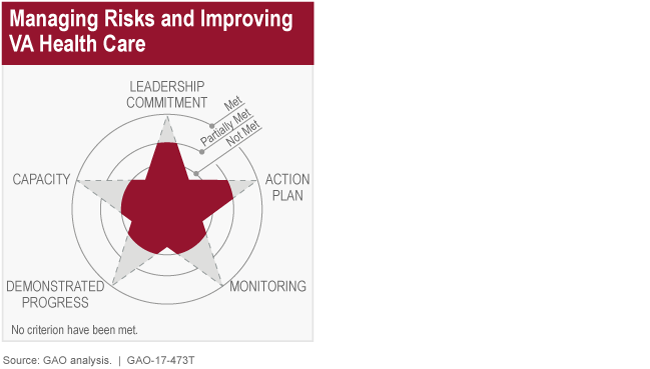Veterans' Health Care: Limited Progress Made to Address Concerns That Led to High-Risk Designation
Fast Facts
We added Department of Veterans Affairs' health care to our High-Risk List in 2015 over concerns about the timeliness, quality, and safety of veterans' health care.
It remains on our 2017 list.
In today's testimony, we discussed how VA partially met 2 of our 5 criteria for getting off the list, and the more than 100 recommendations that remain open, reflecting our areas of concern for VA health care:
(1) Ambiguous policies and inconsistent processes,
(2) Inadequate oversight and accountability,
(3) Information technology challenges,
(4) Inadequate training for VA staff, and
(5) Unclear resource needs and allocation priorities.
VA's Progress in Meeting GAO's Criteria for High-Risk List Removal

Star graphic of VA's rating as reported in GAO's February 2017 High Risk Report (GAO-17-317).
Highlights
What GAO Found
The Department of Veterans Affairs (VA) has taken action to partially meet two of the five criteria GAO uses to assess removal from the High-Risk List (leadership commitment and an action plan), but it has not met the other three (agency capacity, monitoring efforts, and demonstrated progress). Specifically, VA officials have taken leadership actions such as establishing a task force, working groups, and a governance structure for addressing the issues that led to the high-risk designation. VA provided GAO with an action plan in August 2016 that acknowledged the deep-rooted nature of the five areas of concern GAO identified: (1) ambiguous policies and inconsistent processes; (2) inadequate oversight and accountability; (3) information technology challenges; (4) inadequate training for VA staff; and (5) unclear resource needs and allocation priorities. Although VA's action plan outlined some steps VA plans to take over the next several years, several sections were missing analyses of the root causes of the issues, resources needed, and clear metrics to measure progress.

Also of concern are the more than 100 open recommendations GAO has made between January 2010 and February 2017 related to VA health care, almost a quarter of which have been open for 3 or more years. Since February 2015, GAO has made 74 new recommendations relating to the areas of concern.
To address its high-risk designation, additional actions are required of VA, including: (1) demonstrating stronger leadership support as it continues its transition under a new administration; (2) developing an action plan to include root cause analyses for each area of concern, clear metrics to assess progress, and the identification of resources for achieving stated outcomes; and (3) implementing GAO's recommendations, not only to remedy the specific weaknesses identified, but because they may be symptomatic of larger underlying problems that also need to be addressed. Until VA addresses these serious underlying weaknesses, it will be difficult for the department to effectively and efficiently implement improvements addressing the five areas of concern that led to the high-risk designation.
Why GAO Did This Study
VA operates one of the largest health care delivery systems in the nation, including 168 medical centers and more than 1,000 outpatient facilities organized into regional networks. Enrollment in the VA health care system has grown significantly, from 7.9 million in fiscal year 2006 to almost 9 million in fiscal year 2016. Over that same period, VA's Veterans Health Administration's total budgetary resources have increased substantially, from $37.8 billion in fiscal year 2006 to $91.2 billion in fiscal year 2016.
Since 1990, GAO has regularly updated the list of government operations that it has identified as high risk due to their vulnerability to fraud, waste, abuse, and mismanagement, or the need for transformation to address economy, efficiency, or effectiveness challenges. VA health care was added as a high-risk area in 2015 because of concerns about VA's ability to ensure the timeliness, cost-effectiveness, quality, and safety of veterans' health care. GAO assesses High-Risk List removal against five criteria: (1) leadership commitment, (2) capacity, (3) action plan, (4) monitoring, and (5) demonstrated progress.
This statement, which is based on GAO's February 2017 high-risk report, addresses (1) actions VA has taken over the past 2 years to address the areas of concern that led GAO to designate VA health care as high risk, (2) the number of open GAO recommendations related to VA health care, and (3) additional actions VA needs to take to address the concerns that led to the high-risk designation.
For more information, contact Debra A. Draper at (202) 512-7114 or draperd@gao.gov.
